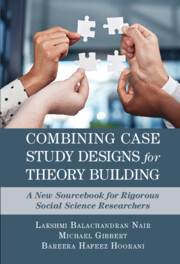 Combining Case Study Designs for Theory Building
Combining Case Study Designs for Theory Building The Evidentiary Basis of Case Studies Is Plural
Published online by Cambridge University Press: 02 February 2023
We discuss multiple case studies in this chapter. We start off with a discussion of theoretical sampling and replication logic. We specifically discuss literal and theoretical replication (LR and TR) in connection with multiple case studies. The strengths and limitations of LR and TR are discussed thereafter. In particular, we deliberate upon the potential of TR to enhance the internal and external validity of a case study. Henceforth, we address some common (mis)conceptions regarding replication logic, internal validity, external validity (generalizability), and reliability. We also discuss how multiple case studies might need to sacrifice the depth of observation for breadth. Other potential weaknesses, such as the smaller number of independent variables and the difficulty in controlling context, are also discussed thereafter.
To save this book to your Kindle, first ensure [email protected] is added to your Approved Personal Document E-mail List under your Personal Document Settings on the Manage Your Content and Devices page of your Amazon account. Then enter the ‘name’ part of your Kindle email address below. Find out more about saving to your Kindle.
Note you can select to save to either the @free.kindle.com or @kindle.com variations. ‘@free.kindle.com’ emails are free but can only be saved to your device when it is connected to wi-fi. ‘@kindle.com’ emails can be delivered even when you are not connected to wi-fi, but note that service fees apply.
Find out more about the Kindle Personal Document Service.
To save content items to your account, please confirm that you agree to abide by our usage policies. If this is the first time you use this feature, you will be asked to authorise Cambridge Core to connect with your account. Find out more about saving content to Dropbox.
To save content items to your account, please confirm that you agree to abide by our usage policies. If this is the first time you use this feature, you will be asked to authorise Cambridge Core to connect with your account. Find out more about saving content to Google Drive.